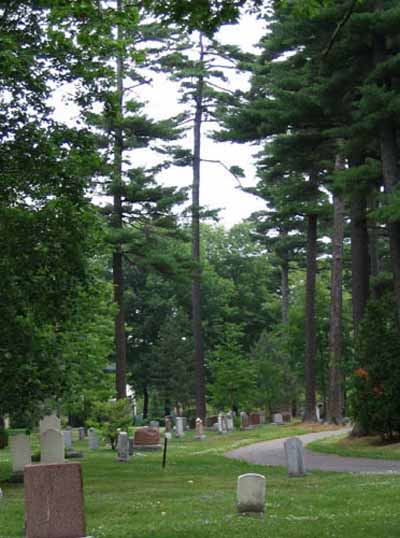Mount Hermon Cemetery National Historic Site of Canada
Québec, Quebec

General view
© Parks Canada Agency / Agence Parcs Canada, Rhona Goodspeed, 2005.
Address :
1801 Saint-Louis Road, Québec, Quebec
Recognition Statute:
Historic Sites and Monuments Act (R.S.C., 1985, c. H-4)
Designation Date:
2007-06-08
Dates:
-
1848 to 1848
(Construction)
Event, Person, Organization:
-
David Bates Douglass
(Architect)
Other Name(s):
-
Mount Hermon Cemetery
(Designation Name)
Research Report Number:
2005-107
Plaque(s)
Existing plaque: 1801, Saint-Louis Road, Québec, Quebec
Established in 1848 for the burial of Protestants from the Québec City region, Mount Hermon is a remarkable example of a small rural cemetery. Characterized by its uneven topography, winding paths, islets of differing sizes, variety of trees, and a spectacular view of the St. Lawrence River, it is laid out in the tradition of a 19th-century-American rural cemetery. Conducive to contemplation, this picturesque setting contains a number of funerary monuments of considerable artistic interest, which commemorate many notable figures and events in Canadian history.
Description of Historic Place
Mount Hermon Cemetery National Historic Site of Canada is a small, attractive example of a rural or garden cemetery. The picturesque cemetery features funerary monuments in a variety of styles as well as a varied landscape with winding roads and a range of different types of trees. It was established in 1848 as a burial site of the various Protestant denominations of the City of Québec, in what is now the Sainte-Foy-Sillery borough of the city. Official recognition refers to the boundaries of the legal property at the time of designation.
Heritage Value
Mount Hermon Cemetery was designated a national historic site of Canada in 2005 because: it is a very attractive example of a small rural cemetery characterized by its uneven topography and naturalistic landscape of many perspectives laid out in the Picturesque manner, its curvilinear roads and islets of irregular curved shapes and differing sizes, its many trees, and in particular an outstanding view of the St. Lawrence River; it includes a number of funerary monuments of artistic and historical interest and which are an exceptional illustration of many aspects of the history of Canada, the province, and the City of Québec.
The Mount Hermon Cemetery was established during the rural cemetery movement in the early 19th-century, in accordance with its principles of creating a naturalistic and pastoral setting. Its Picturesque aspects include a blending of nature and art which can be found in the variety of neoclassical monuments located at the cemetery, in the winding paths and in the panoramic views of the St. Lawrence River. Mount Hermon was the first rural cemetery established in the area around the City of Québec as a result of the need for a new burial site due to overcrowding at the Old Protestant Burying Ground, located within the city.
Source: Historic Sites and Monuments Board of Canada, Minutes, December 2005.
Character-Defining Elements
The key elements that contribute to the heritage character of the site include: the cemetery’s location in the Sainte-Foy-Sillery district of Québec; its Picturesque style landscape of approximately 10 hectares that includes a variety of mature trees, the original layout of roadways, Picturesque viewplanes, and fine views of the St. Lawrence River; its uneven informed topography; its winding paths which surround the irregular curvilinear shapes of the islets; its original receiving vault for storing remains during the winter months; its funerary monuments which range in style, size and materials, which have historical associations for the city, province or nation; the design motifs of the varying styles and sizes of the funerary monuments, including Celtic crosses, obelisks, draped urns, globes, mourning figures and at least one sarcophagus and monuments showing Oriental and Greek influences, as well as one Inuit monument in the form of a small Inukshuk; the materials of the monuments, such as red scotch, pink, grey and black granite, sandstone, limestone and marble; the Lodge, in its Gothic-Revival style, designed in keeping with the naturalistic and Picturesque values of the site; its layout as a park-like space for public use.